(This item was originally written as a description for sale. The speakers were sold soon afterwards.)
This is the best speaker system I have ever owned. Alas, I will likely be moving soon, and it needs to find a new home. I would like to sell the complete system, so the next user can enjoy all the benefit of a fully-realized ready-to-enjoy speaker system. It would be hard to make something like this from scratch — harder than you think. I would know.
The system consists of a vintage wideband horn, used 115-6000 hz, plus subwoofers and tweeters in a multi-amp setup. The efficiency of the main horn is about 110db.
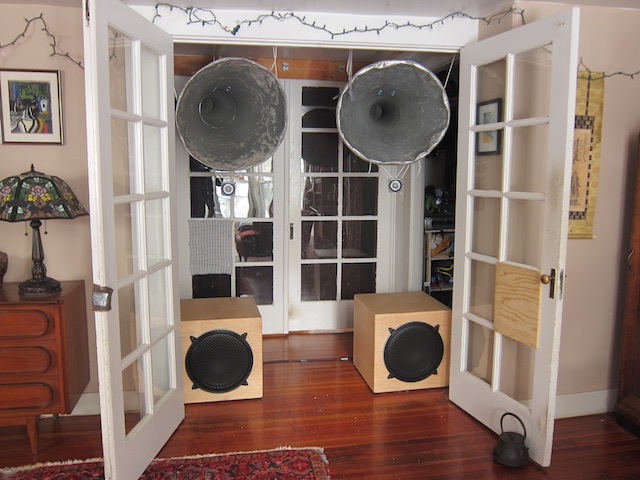
In the past, I have owned and used: Fostex F120A in boxes; JBL LE8 in boxes; Altec 755C on open baffle; Fertin EX20 fieldcoil 8″ fullrange cone drivers on open baffle, with supertweeters and biamped twin 15″ OB woofers below 100hz (the best cone driver speaker I’ve ever heard), Altec Model 14, Altec A5 with 1005 multicell horn and 288B drivers, SET biamped with active tube crossover; RCA theater system with MI-9595 horn, MI-9584 drivers, and MI-9462 “Ubangi” basshorns with twin 15″ Altec 515 drivers per side, biamped with a combo of passive analog and active line-level crossovers; and the “Ubangi” basshorns with these horns, with supertweeters and subs, in a tri-amped arrangement.
The heart of this system is a pair of long wideband horns. The idea of a “wideband” horn, covering all of the midrange with a single horn, was expressed most famously in the Western Electric 15A theater horn system, the speaker that made “talking pictures” possible in the late 1920s and early 1930s. However, by 1936 this was replaced by the two-way “Shearer” system, of a 15″ horn-loaded cone driver and a midrange multicell horn. After WWII, this two-way approach became commonplace with the embrace of the Altec “Voice of the Theater” series.
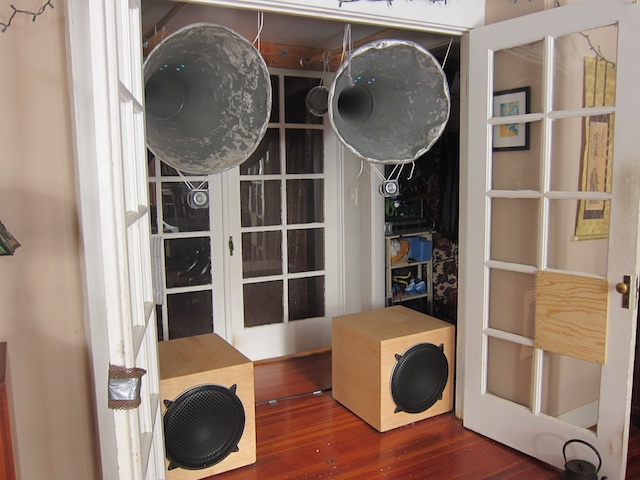
Audiophiles still love the original WE 15A systems today, but they are very expensive, very rare, and very very large.
However, the idea of a “wideband horn” continued after 1936 in designs intended for single-driver public-address-type uses, particularly for voice. This was seen into the early 1950s. Other wideband cone drivers of that era, intended for PA use, have also found embrace by audiophiles today, most notably the Western Electric 755A/Altec 775C 8″ cone drivers originally used for voice systems such as found in public schools, or the Goodmans Axiom 80.
This is a horn of about 5 foot 6 inches long, with two throats combining into one horn. I measured the horns and estimate the flare as 110hz exponential with a quarter-sized mouth. The first part of the horn is heavy cast aluminum. The mouth of the horn is sheet aluminum, and has had quite a few dents, and seems to work fine nevertheless. (A horn expert who owns similar horns once told me the dents probably improve the sound by breaking up standing waves.) The diameter of the mouth is about 22″. I have the horn mouths wrapped with some climbing rope to dampen them. Some sisal or hemp rope would be a bit more picturesque. I was once offered $600 for the horns alone, but it would be silly to break up the horn/driver set.
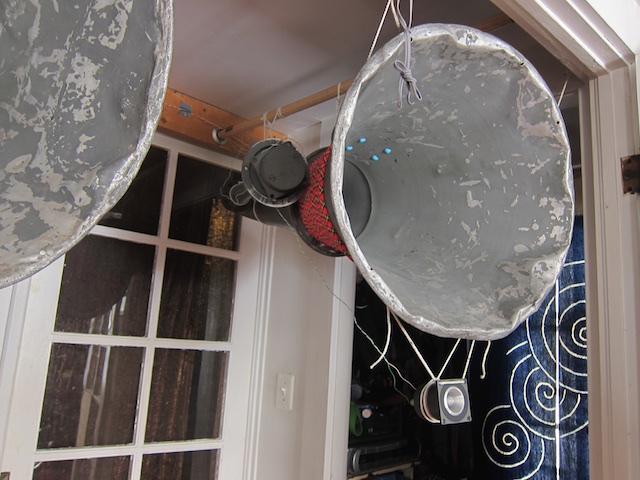
The horns are mated with two pairs (a total of four) Western Electric 720A drivers. These permanent-magnet drivers date from the 1940s, and were intended for use in wideband voice systems like this one, most famously in the Western Electric “Beachmaster” system developed for amphibious military invasion and later repurposed after the war for outdoor voice PA such as sports stadiums. They have similar wideband characteristics to the famous WE 555 drivers used in the 15A system, and I have heard that the diaphragms can be used as drop-in replacements in the 555 although they are phenolic not duralumin. The point is, like the WE555, they can go very low, down to below 100hz on an appropriate horn like this one.
The horn is not Western Electric, but it is compatible with the drivers with a 5/8″ throat. I heard that they date from around 1936, and were probably used with fieldcoil drivers until the original drivers were replaced with more convenient permanent-magnet WE 720As.
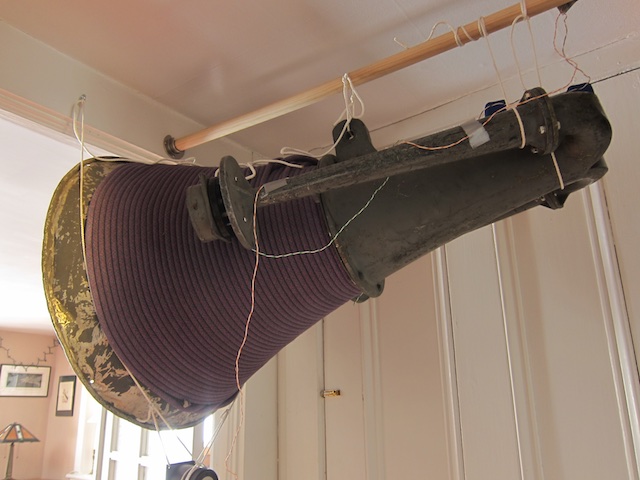
WE 720A drivers like these here typically sell for $900-$1200 per pair on eBay. There are two pairs here. Along the way, these drivers lost their original rear stickers. This bothers some people. However, these drivers came from an original set of gear that included (identical) WE 720A drivers with their stickers. Also, a faint impression of the sticker with the indication “720A receiver” is evident on one of the drivers.
Thus, this horn can be used potentially from 110hz-6000hz, and has an efficiency of about 110db. I use the 8 ohm drivers wired in series for 16 ohms total.

The horns are paired with some 15″ sealed subwoofers in custom-made enclosures. The enclosures are double-wall (two layers of 19mm) birch-ply — very burly! Connections are by professional Speakon jacks. The drivers are Eclipse 8715 with 4-ohm coils, a nice cast-aluminum frame driver for sealed enclosures.
A pair of Fostex FT66H alnico bullet tweeters (8 ohm 106db) completes the system.
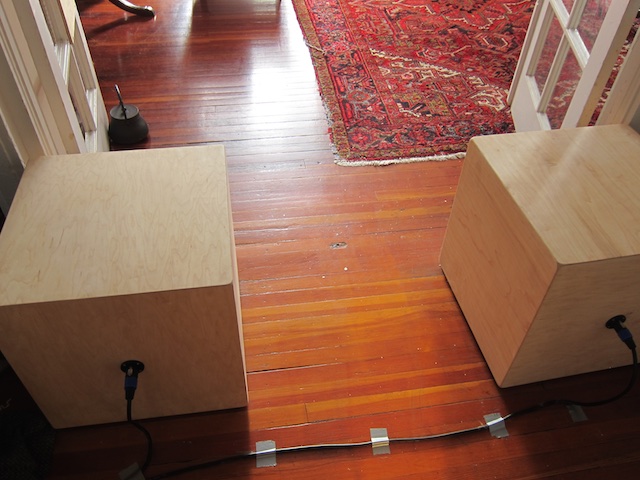
The system is tri-amped. The subwoofers are driven by a 300W@4 ohms NU1000 iNuke 1000 Behringer Class-D power amplifier. The tweeters are driven by a small Chinese SET tube amplifier. At present, the main horns are driven by a pair of 2A3 SET Welborne Labs Moondog amplifiers.
The 2A3 amplifiers for the main horns have a custom passive line-level crossover, 3rd order Butterworth at 115hz with an impedance of 10k ohms. The crossover has separate output level adjustment to match output or for use with different amplifiers. The tweeters and subs use a digital line-level crossover from MiniDSP. The digital crossover allows time alignment of the tweeters and subs, to align them with the very long horns. This was a considerable improvement over nonaligned analog crossovers. The digital crossover is 4th order at 6khz and 115hz. Plus, there is a notch filter at 160hz to eliminate a cabinet resonance in the sub.
The main horns also have a little digital EQ, which is done at the digital source (Audirvana on Mac). The EQ is a +4db lowpass shelf filter around 300hz, to fill out the last octave of the horn. This works great. If you want to use an analog source like a turntable, you might want to add this filter in passive line-level form.
A source with good low-impedance output is necessary to drive the line-level crossover network. The output of my DAC is about 100 ohms, and this is paired with a Sowter transformer volume control. A similar low-impedance digital source with analog volume control, or an active preamp, can serve in this role. No resistive “passive preamps” please.
What you get:
Vintage horns with two pairs of WE720A drivers
Pair of Fostex FT66 bullet tweeters
Pair of 15″ sealed subs in custom enclosures
Small 2w SET tube amplifier for tweeters
Behringer amplifier for subwoofers
MiniDSP digital crossover, preprogrammed for this system, and power supply.
Custom analog line-level crossover
Wire and cable including Speakon speaker cables for the subwoofers
Optional:
Pair of Welborne Labs 2A3 amplifiers (sound awesome on these horns)
Sowter transformer volume control (recommended if you need a volume control from a digital source).
What you need if using 2A3 amps and transformer volume control:
A low impedance digital source like a DAC. I use the Metrum Octave DAC, which is a lot better than other options I have used, and also as good or better than my turntable, which is no longer set up.
What you need if using a turntable:
A phono preamp plus an active preamp, with output impedance of less than 1000 ohms (most all tube linestages should do this).
Probably, the 4db shelf correction as mentioned, in analog line-level form, although the system can work without this. I can provide this if needed.
Note that the horns have a quarter-sized mouth. Thus, in free air, they tend to roll off around 200-250hz. In this system, they should be used in a close approximation of quarter-space; in other words, either near an intersection of a wall-floor boundary, or near the floor and close to each other side-by-side. In my installation, the combination of ceiling, French doors, walls, and proximity to each other accomplishes this quarter-space loading which allows response to 110hz. The new owner should aim to replicate this quarter-space loading for this system to work properly. I would recommend positioning near the floor, for example, by putting the horns on top of the subwoofer enclosures such that the edge of the horn overlaps the subwoofer driver and is within 18″ of the floor. (This would also have better integration than the widely separated setup I have here.) Then, the horns can either be positioned relatively close to one another (within 18″ apart between the edges of the two horns for example), or, better yet, near a side boundary such as within 18″ of a side wall. In a pinch, a rear boundary such as positioning as close to a rear wall as possible is a good alternative, although the long length of the horns will prevent positioning very close to rear walls. I have also listened to these horns laying straight on the floor, which looks a bit odd but works fine. You might note that this combination of factors (close to both floor and side walls ideal) is well suited for a smaller listening room. Having just one wideband device also eliminates the need to “blend” very large and disparate drivers in a large horn system, which is also an advantage in smaller rooms.
This is a complicated system. Although I don’t think one needs to be an experienced DIY speaker builder to use it, comfort with and willingness to tweak and experiment would be best. This is not plug-and-play speaker for someone who just wants to connect one pair of speaker wires and be done with it, and it is not “ruggedized” for large-scale commercial distribution to the masses. It is definitely not sold in stores, and never will be. Unless you count a handful of similar WE 15A or Mirrorphonic systems, I don’t know of another system like this in North America.
Thus, if you are the kind of person who needs confirmation from “professional reviewers” and perhaps the conventional wisdom of certain message boards and chat rooms (90% of whose participants have never owned anything nearly as good as the speakers I had ten years ago), then maybe you should follow that road wherever it may lead you. Good luck.
If you are the kind of person who wants something special … even if it is a little impractical … this is something special.
How does it sound?
It sounds great. That’s why I’m listening to them here, instead of the long list of gear I used to own, or a long list of gear I could own.
I prefer the midrange sound of this horn and driver combo to the famous Altec 1005/288 combo and RCA 9595/9584 combo, paired and biamped with their matching bass cabinets, both of which I have owned. I haven’t heard the WE 15A/555 combo, but it is possible that I would prefer this, as the very long (13 feet spiral) 15A horn may potentially compromise the midrange on that system.
I have used these horns combined with the RCA MI-9462 “Ubangi” twin 15″ basshorns. This combo had an awesome sense of scale and majesty. However, it is very, very large! Also, the ability to cover the entire voice range, 115hz to 6000hz, with a single device, provides advantages of coherence and unity. The Ubangi basshorns actually go down only to about 80hz (when used without their attached ported boxes as I did), despite their enormous size, and also required a subwoofer. So, this horn alone nearly covers that whole range, when used as described with quarter-space loading.
These horns have nearly all the advantages of the best cone-driver speaker I have owned or heard, the Fertin EX20 fieldcoil 8″ widebanders. For a time, I listened to both side-by-side, using the same open-baffle woofers for bass. The horns also have much higher efficiency, that awesome horn “jump factor”, and immense headroom and dynamic range.
However, let me say that, like most vintage and widebander approaches, this system is rather quirky. It is not the kind of system that is “perfect” from an engineering standpoint, or even a listening standpoint. It is a system of soul and emotion, and expresses that brilliantly. This system is perhaps suited to someone who has already gone the wideband-cone route, and recognizes both their appeal (liveliness and coherence) and their limitations (efficiency and dynamics, and all the imperfections that come from wideband approaches).
Like all round horns not specifically designed for constant-directivity, including contemporary tractrix or Le Cleach designs, these horns are very beamy. In practice, this can take a little getting used to, but after a while I find it is not a big problem.
The very high efficiency of this system is perfect for mating with low-power triode amplifiers like 2A3 or 45.
Let me make a few notes about dynamics. At 110db/w/m and 16 ohms (wired in series), my 2A3 SET amplifiers can deliver about 1600mW at peaks. Thus, the peak output is about 112db, at 1.6 watts and one meter in open space. This is comparable to measured peaks at the listening position for either classical (unamplified) or popular (amplified) music in live performance, typically around 114db.
In practice, typical moderate listening levels tend to be around 85db at the listening position, although this can vary depending on the type of music and the listener’s preferences. A large room will demand more output capability. Large-scale music sounds funny when played at the low absolute levels appropriate for acoustic guitar and breathy vocals. (In practice, the combination of room reflection and the fact that there are two speakers, not one, means that listening seat levels are around the same as rated 1-meter efficiency output, in a typical living room.) Obviously, 112db gives 27db of headroom in this case, which probably seems like plenty.
However, a lot of highly dynamic, uncompressed recordings, whether classical, rock or jazz, are quite commonly done at average levels of about -23db and peak levels of -3 to 0 db. For example, here’s Rickie Lee Jones’ 1981 rock/pop album, Pirates:
———————————————————————————————-
DR Peak RMS Filename
———————————————————————————————-
DR16 -1.47 dB -23.11 dB 01 We Belong Together.wav
DR14 -2.24 dB -21.34 dB 02 Living It Up.wav
DR14 -8.89 dB -30.12 dB 03 Skeletons [Live].wav
DR15 -2.13 dB -21.04 dB 04 Woody and Dutch on the Slow Train to Peking.wav
DR14 -1.91 dB -21.05 dB 05 Pirates (So Long Lonely Avenue).wav
DR14 -4.32 dB -23.19 dB 06 A Lucky Guy.wav
DR18 -1.11 dB -23.91 dB 07 Traces of the Western Slopes.wav
DR14 -12.28 dB -32.36 dB 08 The Returns [Live].wav
———————————————————————————————-
We see that the average whole-track RMS levels are commonly in the -20 to -25 db range, and the peaks are around -1db. In other words, if the peaks are at your maximum amplifier output of 112 db, the average listening level would be around 90db, which is not particularly loud for a rock album if you want to turn it up a bit.
Here’s the famous Telarc recording of the 1812 Overture:
DR Peak RMS Duration Track
——————————————————————————–
DR18 -2.86 dB -27.76 dB 15:49 ?-01 – Erich Kunzel Cincinnati Pops Orchestra – 1812 Overture, Op. 49
DR13 -10.08 dB -27.70 dB 4:37 ?-02 – Erich Kunzel Cincinnati Pops Orchestra – Polonoise from Eugene Onegin, Op. 24
DR16 -4.74 dB -28.03 dB 15:46 ?-03 – Erich Kunzel Cincinnati Pops Orchestra – Capriccio Italien, Op. 45
DR14 -4.77 dB -25.22 dB 9:38 ?-04 – Erich Kunzel Cincinnati Pops Orchestra – Marche Slave, Op. 31
DR14 -10.92 dB -30.12 dB 6:46 ?-05 – Erich Kunzel Cincinnati Pops Orchestra – Waltz from Eugene Onegin, Op. 24
DR13 -6.25 dB -23.67 dB 4:47 ?-06 – Erich Kunzel Cincinnati Pops Orchestra – Festival Coronation March
DR16 -5.25 dB -27.65 dB 4:23 ?-07 – Erich Kunzel Cincinnati Pops Orchestra – Cossack Dance from Mazeppa
——————————————————————————–
The average RMS is about 25 db below the peaks. So, that would mean 112db peaks at max amplifier output, and 87db average listening levels.
Here’s a typical jazz album from the 1980s, before dynamic compression became commonplace. This is the Chick Corea Elektric Band, Light Years (1987).
DR Peak RMS Duration Track
——————————————————————————–
DR16 -0.36 dB -19.93 dB 3:56 01-Light Years
DR15 -0.69 dB -19.63 dB 4:15 02-Second Sight
DR15 -0.77 dB -18.63 dB 4:13 03-Flamingo
DR16 -2.59 dB -21.21 dB 3:33 04-Prism
DR14 -1.31 dB -18.22 dB 5:06 05-Time Track
DR14 -0.86 dB -18.56 dB 3:54 06-Starlight
DR16 -1.52 dB -19.53 dB 4:01 07-Your Eyes
DR17 -0.32 dB -21.25 dB 5:35 08-The Dragon
DR15 -0.32 dB -17.41 dB 6:34 09-View From The Outside
DR15 -3.86 dB -21.66 dB 4:28 10-Smokescreen
DR13 -3.73 dB -22.09 dB 6:44 11-Hymn Of The Heart
DR16 -0.77 dB -20.41 dB 8:06 12-Kaleidoscope
——————————————————————————–
Again, we’re getting 20db peaks above average track RMS levels. Admittedly, most music today doesn’t have this kind of dynamic range — but it should. Any music with a drum kit has immense dynamics coming off the microphone, it is just rounded off in postproduction.
What does this mean?
It means that this system can deliver the full intended dynamics on the recording, using a low-power SET amplifier.
It also means that, if you aren’t using a system with similar efficiency with your <5W amplifier, it is clipping regularly — even at modest listening levels. I’ll let you figure out what is happening on typical 98db “high efficiency” speakers, or even typical 90db cone speakers. The “soft clipping” characteristic of Class A tube electronics gives these amplifiers their somewhat “soft” sound. However, when you finally unleash them with this kind of speaker, you get the dynamics, the drama, the expression — plus that liquid DHT SET midrange — that these amps are really capable of. (Note that wiring these speakers for 16 ohms and using them on the 8-ohm output, as I am here, also improves the damping factor considerably, adding to the sense of whipcrack dynamics.)
A 110db speaker at one watt produces the same output as a 98db speaker at about 16 watts and a typical 87db cone speaker at 200 watts. In other words, a one-watt 45 SET amp on these speakers has as much output capability as a 200 watt solid state amp on a typical “audiophile” cones and domes speaker. However, there’s more to it than that. If you put 200 watts through the 6″ paper cone driver (actual diaphragm about 4.5″ in diameter) typical of a multiway cone speaker, the little paper disc can’t really produce 110db peaks properly. It is just a little piece of paper. It takes horn loading to couple with the air to produce those kinds of acoustic peaks. So, in practice, even if you do put 200 watts through your 87db cone speaker, you still aren’t getting the proper dynamic peaks, or if you are, you are also getting a ton of distortion as that little paper disc flaps itself to death trying to keep up with the demands you are putting on it. All of this counts triple for wideband cone driver approaches, where the cone also has to produce bass and treble without distortion, and thus begins to break up unpleasantly at much lower levels of output than similar size cone drivers used in their pistonic range alone, as in a multi-way cone speaker. Now, consider that 6″ cone driver being flapped to death with 200 watt peaks, compared to the 800 milliwatts (half of 1.6 watts, two drivers per channel) that one of these 720A compression drivers sees at max peak output on this system–to create the same acoustic output. So, in practice, a one-watt 45 amp can produce better dynamics on a horn like this than 200, or 1000 or 10,000 watts flapping a 6″ paper circle in the air.
Plus, we have here the 106db horn-loaded bullet tweeters and twin 15″ sealed subwoofers strapped to big bulk power to keep up in the bass and treble. I invite you to consider the capabilities of a multi-amped horn tweeter, crossed at 6khz fourth-order, compared to a typical 1″ dome tweeter crossed at 2500hz, which is audibly being pushed to its ragged edge even on girl-and-guitar music. One reason for the big subwoofers is not peak output — although that is important — but also the ability to move a lot of air even at very modest levels. In practice, having lots of cone surface area, like twin 15″ drivers instead of 8″ woofers, gives a sense of scale and grandeur even in small rooms and at very modest levels. It’s not just about playing loud. This is important also for integration with the big horns.
For the horns too, it is not just about playing loud. Horn loading and compression drivers have a certain edge-of-your-seat “electricity” which is apparent even at the lowest whisper levels. Your breathy lady vocalists never sounded better, especially with the entire voice range reproduced with a single driver … originally intended for voice reproduction.
In short, this is the kind of speaker you want to be using with your low power SET gear, even if perhaps you don’t know it yet. Yes, I know your 300B amp “sounds great” with your 90db Altec 755s, or 93db Fostex wideband cone drivers, but it could sound a whole lot greater. I used to listen to systems like that too, and I don’t anymore.
I think one reason for the tendency for audiophiles to focus on breathy vocal “girl and guitar” music, or small-group jazz, is because their systems actually can’t handle much more than this.
Plus, we have all the advantages of multi-amping here. Connecting amp outputs directly to the drivers, with no speaker-level crossovers, adds a level of immediacy and directness that can’t be obtained any other way. SET amps directly wired to compression drivers, without speaker-level crossovers, is the ultimate audio drug, as anyone who has tried it will attest. Plus, we relieve the main amps of any duties to produce bass below 115hz or treble above 6khz, allowing them to focus on what they excel at, that fabulous midrange.
If you’ve been traveling the single-ended triode path (or even low-power solid state), you know that, despite what reviewers claim about their flavor-of-the-week amplifiers and speakers, nothing much sounds better. But, the limitations are acute! If you have some ambition in these matters, this is a good way to go. Try it for two years, and tell me if you agree.

